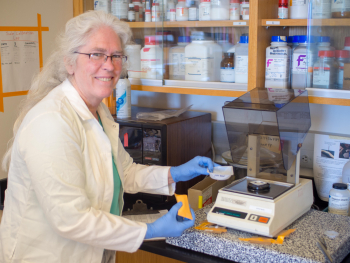
School:
RJ Frank Middle School
Grade Level:
Junior High
Teaching Position:
7th grade general science
Supervisor:
Susan Mazer
Department:
EEMB
Mentor:
Susan Mazer and Amber Eule-Nashoba
Research Project Year:
2018
Research Project Title:
Evolutionary adaptation in Nemophilia menziesii across a climate gradient in California
Research Project Description:
I worked on Professor Susan Mazer’s NSF-funded research on the process of evolutionary adaptation of native plants to intensifying drought. The research started with collecting Nemophilla menziesii (Baby Blue Eyes) seeds from 4 wild populations in California. I helped to remove seeds from their fruits, count and sort the seeds by size, and weigh them to measure mean seed mass per population. After this was done for all four populations, I weighed the seeds, recorded their total mass, and then calculated mean individual seed mass (the average mass of an individual seed) for each population. I then conducted statistical analyses to detect and to characterize variation between and within the four populations. Results from this initial dataset show that there is variation in mean individual seed mass across the four study sites, presumably due to natural selection in response to temperature and precipitation. Populations occupying drier and warmer sites produced relatively large seeds, while the population occupying the wettest and coldest site produced the smallest seeds. Ongoing work under greenhouse conditions will determine whether the differences among populations observed in the field are maintained under relatively uniform experimental conditions, which would indicate that the differences observed among field populations are likely to have a genetic basis.
Curriculum Project Year:
2019
Curriculum Project Title:
Seed Dispersal as an Introduction to Ecology
Curriculum Project Description:
In this unit students will be investigating seed dispersal. Students will examine the types of seed dispersal, the many unique seed structures needed for seed dispersal, and the role of animals and Earth’s systems play in this dispersal. During an initial activity students will observe and record plant growth from seed germination to seed dispersal. This will be used as a daily 5 minute warm up for 5 to 6 weeks. In the seed dispersal labs, students will make predictions about seed dispersal for different types of seeds and then test these predictions. Student pairs will create a model to better understand how specific characteristics are beneficial to specific types of seed dispersal. The final activity will use some real data from my research to have students compare the effect of rainfall on seed size followed by a nature walk with observations.
